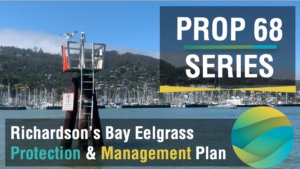Prop 68 Climate Resilience Miniseries Episode 1: Richardson’s Bay Regional Agency Eelgrass Protection & Management Plan
(Intro to the series here)
“This is a huge deal because we are on the cusp of something that is hopefully going to make a difference” – Curtis Havel
Today we are in Northern California, visiting the beautiful town of Sausalito to learn about a Prop 68 Project to establish an Eelgrass Protection and Management Plan (EPMP) for Richardson’s Bay. We met up with Curtis Havel, the Richardson’s Bay Regional Agency Harbormaster and Rebecca Schwartz Lesberg, President and Founder of Coastal Policy Solutions to discuss their efforts to finalize and begin implementation of Phase 1 of the EPMP. The EPMP is part of the Transition Plan enacted by the RBRA Board of Directors in June of 2020. This project involves many different stakeholders–from regular users of the anchorage to state agency staff, academics, researchers, restoration practitioners, community-based organizations, and non-profit organizations. “We have had a lot of stakeholders involved…to make sure that their unique perspectives are included” stated Rebecca.

To develop the boundaries of the EPMP, the project team used a marine spatial planning approach to better manage the use of Richardson’s Bay by delineating an ‘Eelgrass Protection Zone’ where anchoring will not be permitted. This area is also quite shallow, at Mean Lower Low Water (MLLW) the ‘Eelgrass Protection Zone’ is 5 feet or less deep, making it difficult for mariners to safely anchor. In clarifying the goals of the EPMP, Curtis commented that the plan “does not prohibit people from enjoying the area…you can still get on your boat and sail through the area, paddle board, kayak, or swim…you can still enjoy it”.
The implementation of the EPMP relies on four components, listed below:
- Finalize the EPMP, which happens at the level of the RBRA Board of Directors, received final approval on August 12, 2021.
- Implement their Education and Outreach Plan–where they will engage with the communities that use the Bay for recreational activities (kayaking, swimming, boating) and anchoring on the water. They will also present at local community group meetings and lead local workshops to communicate to the public why these changes are being made (e.g. the establishment of the ‘Eelgrass Protection Zone’) and to alert the public of the wealth of natural resources that the EPMP seeks to protect, for their benefit.
- Enact regulatory changes at local and regional level and work with the U.S. Coast Guard to update nautical charts and Coast Pilot which guides mariners moving in and out of the Bay.
- Conduct wildlife and habitat monitoring to assess baseline conditions and track how the EPMP impacts wildlife that utilize the Bay, and particularly the eelgrass meadows. This is going to be done in close partnership with Audubon California.
Richardson’s Bay supports over 90% of the herring spawning in the greater San Francisco Bay. The herring eggs deposited on eelgrass blades support thousands of waterbirds that feverishly forage on the masses of eggs, characteristic of the seasonal herring run which has experienced a series of boom-bust cycles in recent years, concerning the commercial fishery.
Rebecca’s role is to work closely with Curtis Havel and Jim Malcolm (RBRA Staff) to thread all of these components together to develop a comprehensive and adaptive management plan for eelgrass within the Bay.
“Sometimes there are certain points of views that it has to be all or nothing and I think this is an opportunity where we can have a joining of uses where we preserve, promote, and protect that resource [eelgrass] but we still get to enjoy it.” comments Curtis. The team has made steady progress and the final EPMP was approved by the RBRA Board of Directors on August 12th.
To learn more about this project, check out this video!
About Curtis: Curtis Havel is the RBRA Habormaster, one of two staff (Jim Malcom, Assistant Harbormaster) helping manage the Anchorage.
About Rebecca: Rebecca Schwartz Lesberg is a consultant working with RBRA. She focuses on the intersection of science, policy, restoration, and community engagement to protect California’s coastal environments.
About the Author: Dr. Kathryn Beheshti is a 2021 California Sea Grant State Fellow with the Ocean Protection Council’s Climate Change Program. Kat’s own research focuses on understanding the drivers of loss and recovery of key coastal foundation species (e.g. salt marsh plants and seagrasses). Kat is committed to making science accessible to individuals of all ages and demographics. She hosts her own science communication platform, sloughit.com and participates in an interdisciplinary science communication team at SciAll.org, where she is a Lead Vlogger.

